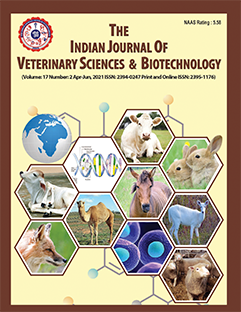Periodontal Disease in Dogs: Incidence and Comparative Efficacy of Ozonated Water versus Demineralized Water in Dental Scaling
DOI:
https://doi.org/10.48165/ijvsbt.21.6.10Keywords:
Bacterial load, Canine, Dental scaling, Incidence, Ozonated water, Periodontal diseaseAbstract
A retrospective study of 6,141 canine cases presented to the Veterinary Clinical Complex, Kamdhenu University, Anand (August 2023 to July 2024), identified 87 (1.42%) cases with oral affections. Of these, 21 (24.13%) were diagnosed with periodontal disease. Higher incidence was noted in male and older dogs, the most affected breeds being Labrador Retrievers, German Shepherds, and Pomeranian Spitz. Dogs on soft or vegetarian diets without oral hygiene showed increased susceptibility. Clinically, halitosis, abnormal salivation, dental plaque, and calculus were the predominant findings. In a therapeutic trial with 14 affected dogs, two groups of seven received ultrasonic dental scaling with either ozonated or demineralized water. Gram-positive cocci were the predominant isolates from dental swabs, and Amikacin showed the highest antibiotic sensitivity (71.42%). Scaling with ozonated water reduced bacterial load significantly (from 74.14 ± 8.13 ×10³ to 32.57 ± 4.77 ×10³ CFU/mL; p = 0.001), whereas demineralized water produced no significant change (79.86 ± 8.43 ×10³ to 70.00 ± 7.61 ×10³ CFU/mL; p = 0.064). These findings underscore the high incidence of periodontal disease in specific canine demographics and demonstrate the superior antibacterial efficacy of ozonated water in canine periodontal disease management through dental scaling. These findings suggest that ozonated water is more effective for bacterial control in periodontal lesions.
Downloads
References
Archana, A. (2009). Evaluation and management of dental affections in dogs. Doctoral Dissertation. College of Veterinary and Animal Sciences, Mannuthy, KVASU, Thrissur, Kerala, India.
Aswathy, P., Narayanan, M.K., Devanand, C.B., Sudheesh, S.N., & Ambily, R. (2019). Oral and maxilla-facial disorders in canines - An incidence study. Journal of Veterinary and Animal Science, 50(2), 85-88.
Butkovic, V., Šehič, M., Stanin, D., Šimpraga, M., Capak, D., & Kos, J. (2001). Dental diseases in dogs: A retrospective study of radiological data. Acta Veterinaria Brno, 70(2), 203-208.
Eisner, E.R. (1989). Helping clients care for their pets’ teeth at home. Veterinary Medicine, 12, 1070-1074.
Fadden, T., & Marretta, S.M. (2013). Consequences of untreated periodontal disease in dogs and cats. Journal of Veterinary Dentistry, 30(4), 266-275.
Gorrel, C. (2013). Veterinary Dentistry for the General Practitioner. Elsevier Health Sciences.
Harvey, C.E. (2005). Management of periodontal disease: understanding the options. Veterinary Clinics: Small Animal Practice, 35(4), 819-836.
Kumar, V., Kelawala, N.H., Patil, D.B., Parikh, P.V., & Barvalia, D.R. (2008). Epidemiological studies on periodontal diseases in dogs. Indian Journal of Veterinary Surgery, 29(2), 112-113.
Listgarten, M.A., & Ellegaard, B. (1973). Electron microscopic evidence of a cellular attachment between junctional epithelium and dental calculus. Journal of Periodontal Research, 8(3), 143-150.
Lyon, K.F. (2000). Precision automated ultrasonic scaling equipment (PAUSE) for preventing periodontal disease in companion animals. In Proceedings of 14th Annual Veterinary Dental Forum, Vol. 1, pp. 153-162.
Martin, J.K.D., Archana, A., Sarada Amma, S.T., Narayanan, M.K., & Pillai, U.N. (2011). Occurrence of dental affections in dogs – A study in 150 cases. Indian Journal of Canine Practice, 3(2), 138–139.
Mithun, D.K. (2017). Clinical studies on surgical management of periodontal diseases in dogs. Doctoral Dissertation. Junagadh Agricultural University, Junagadh, Gujarat, India.
Nagayoshi, M., Kitamura, C., Fukuizumi, T., Nishihara, T., & Terashita, M. (2004). Antimicrobial effect of ozonated water on bacteria invading dentinal tubules. Journal of Endodontics, 30(11), 778-781.
Niemiec, B.A. (2008). Periodontal disease. Topics in Companion Animal Medicine, 23(2), 72-80.
Pai, T.P. (2018). Clinical evaluation of effect of dental scaling and polishing on periodontal disease in dogs. Doctoral Dissertation. Maharashtra Animal and Fishery Sciences University, Nagpur, India.
Pattanaik, B., Jetwa, D., Pattanaik, S., Manglekar, S., Naitam, D.N., & Dani, A. (2011). Ozone therapy in dentistry: A literature review. Journal of Interdisciplinary Dentistry, 1(2), 87-92.
Ramzy, M.I., Gomaa, H.E., Mostafa, M.I., & Zaki, B.M. (2005). Management of aggressive periodontitis using ozonized water. Egyptian Medical Journal of the National Research Center, 6(1), 229–245.
Rawlinson, J. (2003). Common oral lesions - A pictorial guide. Waltham Focus, 13, 18-23.
Saini, R. (2011). Ozone therapy in dentistry: A strategic review. Journal of Natural Science, Biology and Medicine, 2(2), 151.
Sarkiala, E., Asikainen, S., Wolf, J., Kanervo, A., Happonen, I., & Jousimies-Somer, H. (1993). Clinical, radiological and bacteriological findings in canine periodontitis. Journal of Small Animal Practice, 34(6), 265-270.
Seidler, V., Linetskiy, I., Hubálková, H., Stanková, H., Smucler, R., & Mazánek, J. (2008). Ozone and its usage in general medicine and dentistry. A review. Prague Medical Reports, 109(1), 5-13.
Sisodiya, J.H. (2005). Use of ultrasonic dental scaler for prevention and treatment of periodontal disease in dogs (Canis domestica). MVSc Dissertation. Anand Agricultural University, Anand, Gujarat, India.
Srikanth, A., Sathish, M., & Harsha, A.V.S. (2013). Application of ozone in the treatment of periodontal disease. Journal of Pharmacy and Bioallied Sciences, 5(Suppl 1), S89-S94.
Syed, S.A. (1980). Characteristics of Bacteroides asaccharolyticus from dental plaques of Beagle dogs. Journal of Clinical Microbiology, 11(5), 522-526.
Vani, G., Haragopal, V., Kumar, R.V.S., & Rao, T.S.C. (2007). Incidence of dental affections in dogs. Indian Veterinary Journal, 84(9), 974-975.
Zambori, C., Tirziu, E., Nichita, I., Cumpanasoiu, C., Gros, R.V., Seres, M., ... & Mot, D. (2012). Biofilm implication in oral diseases of dogs and cats. Animal Science and Biotechnologies, 45(2), 208-208.
Downloads
Published
Issue
Section
License
Copyright (c) 2025 Indian Journal of Veterinary Sciences and Biotechnology

This work is licensed under a Creative Commons Attribution-NonCommercial-NoDerivatives 4.0 International License.




